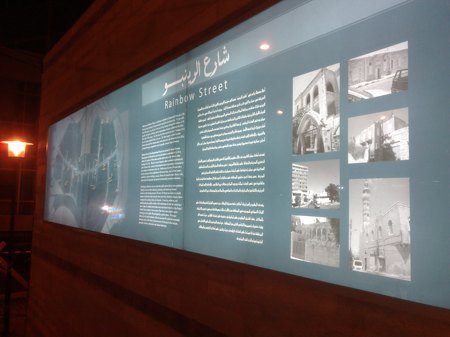
The new lights of Rainbow Street are on! I just came back from a quick 30 minute visit to the street. I wanted to check out the street’s new developments and also document a creeping danger that is threatening the street’s urban identity.
I will not elaborate on the interventions that were made as part of the street’s renewal process. I prefer to to let the quick photos tell their own story. Overall, I like what I saw. Even the controversial cobblestone paving of the street is OK by me. I think it’s a good idea to force drivers to slow down when they drive through Rainbow street, making it more pedestrian friendly. If, for special occasions the street is closed fro traffic, the cobblestone will give it a pleasant atmosphere.
The new additions to the street are a mixed bag. Some are good, like the lighting and big introductory map/sign. Some are extremely gimmicky, like the “prism” sculpture on the new terraced plaza at the entrance of the street. Just think of it: glass prism + lots of nice big stones around them + kids! I swear that even on a chilly night like tonight there was only one woman with her little daughter near the glass prism and I saw a stone fly out of the girls hand, luckily near a wall on not on the glass.
Tidying up the street is a great initiative for a fabulous street..
But there is a scary danger looming that has the potential to absolutely wreck the street:
The fake “village” style that is popping up here and there.
This is not the direct fault of the renewal project. Blame it on shop owner’s lack of understanding of what kind of ‘heritage’ this street represents.
If Rainbow Street celebrates any ‘heritage’, then it is the ‘heritage of modernity’. It reflects the development of Amman in modern times: the birth of the Kingdom of Jordan in the 20th Century. Cinema (the street was named after famous Rainbow Cinema).The western influences on shopping (it was the exclusive shopping street of the elite in the past), education, the growth of corporations (Jordan Petroleum Refinery Building, openness to foreign cultures (The British Council), new building styles (Amman’s first high rise, the Insurance Building was built on the First Circle) and so on..
Rainbow Street is the story of the emergence of Modern Amman.
Rainbow Street is NOT about village life. It is NOT about old wooden doors. It is NOT about yellow stone arches and pergolas.
Yet, it is exactly this fake “village style” that some shop owners are plastering on the facades of Rainbow. With all respect to the intentions of the shop/restaurant owners whose facades are pictured in the last four photos below, they have to know that they totally misunderstand what Rainbow is about.
Most Ammanis architectural and urban vocabulary does not go beyond:
Modern = Glass Tower (like Dubai)
Heritage = Arches and Uneven Stone (Like Great Grandfather’s village)
There is almost no understanding for ‘modern heritage’. Modern heritage is all about the transition of Amman into the 20th Century.
If Rainbow Street is allowed to be taken over by this misunderstanding of its character it will become, in one year, a totally fake touristy place that has nothing to do with its real story. That would be utterly sad.
So. I deeply hope that the people in the Greater Amman Municipality responsible for the street’s renewal, pay attention to the identity of Rainbow and make sure that the street’s original spirit is preserved. The best way to preserve it is to just leave the buildings alone and provide some guidelines for signage. The street already has good examples of signage (definitely not made to look like broken wood from a farm!!).
The renewal of Rainbow Street can be such a great catalyst for urban renewal across Amman. It should not allowed to be hijacked by a ‘Kan Zaman’ style.
I leave you with the photos:
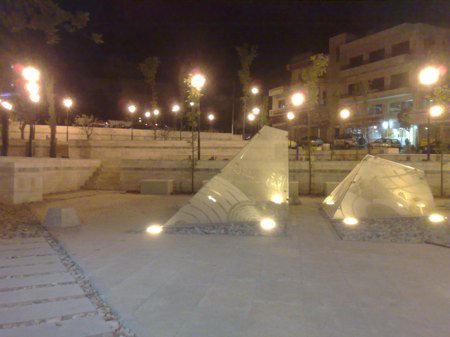
Entrance plaza. Not a bad public place. But stones near glass pyramids??
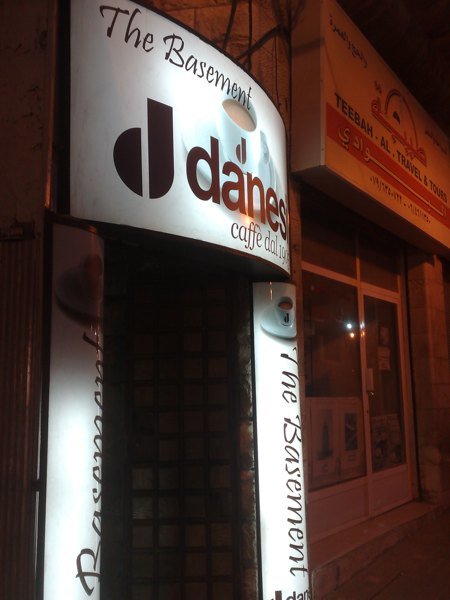
This place sort of fits the spirit of Rainbow. But too much neon.
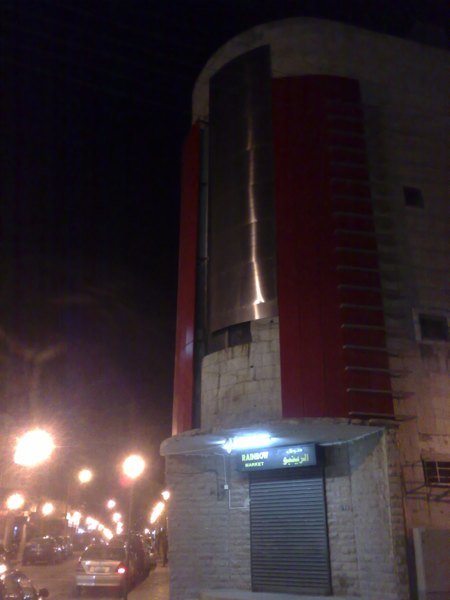
The old movie theatre that gave Rainbow Street its name. I am not so sure about the red aluminum cladding. Does anyone have an old photo of this cinema?
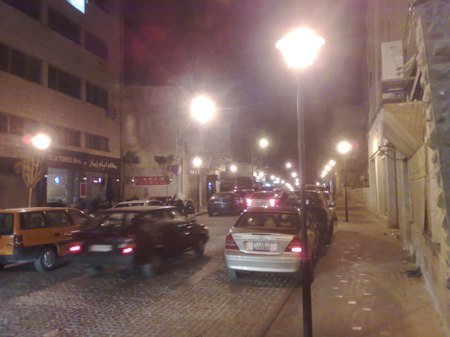
Modern lighting works well. Cobblestone give the street some warmth.
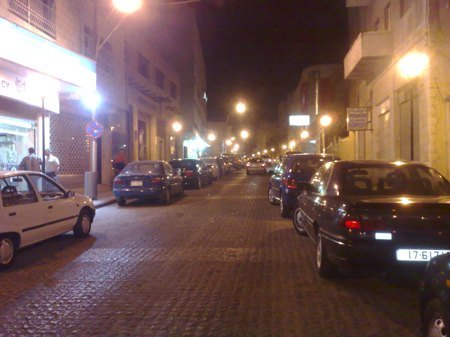
A civil atmosphere.
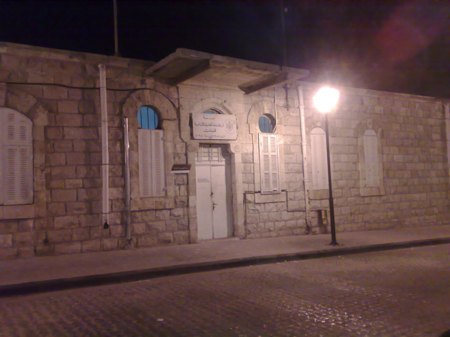
An example of early Amman architecture: This is an now a public school.

New trees and benches will make this wide sidewalk look great in a few years.
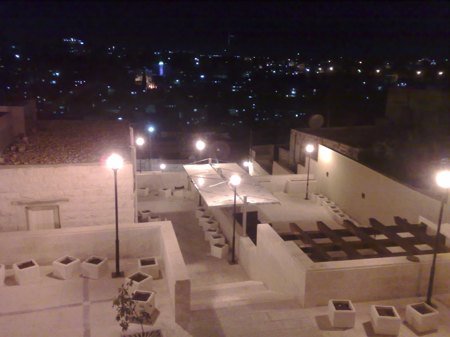
Panoramic terrace.. Nice idea but a bit gimmicky. And what is that pergola doing there?
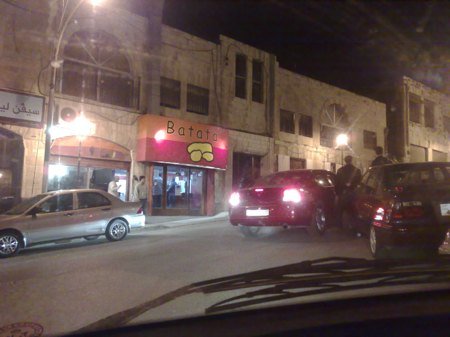
Batata: Here since the mid 1990’s. THe vibrant sign works well. I am not saying all signs need to be like this one. The diversity of signs is a feature of Rainbow.
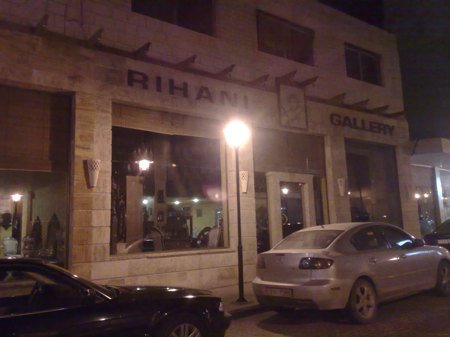
Fake wooden beams and yellow stone. Definitely the wrong style.
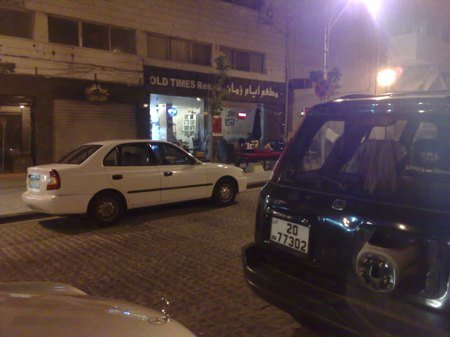
Modernist building with wide windows.. destroyed by the street level restaurant and gift shop facades in brown plaster. Wrong. Wrong. Wrong!
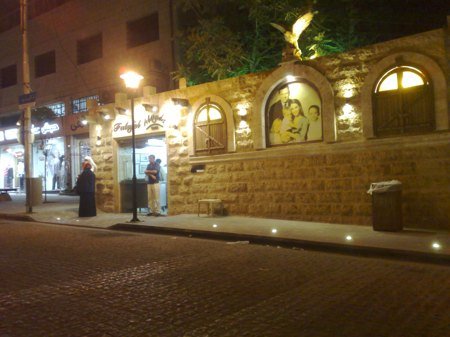
Good intentions gone bad. The famous Al Quds Falafel shop. Now with fake village facade, complete with face wooden window shutters. And, unbelievably, an ENGLISH ONLY sign.
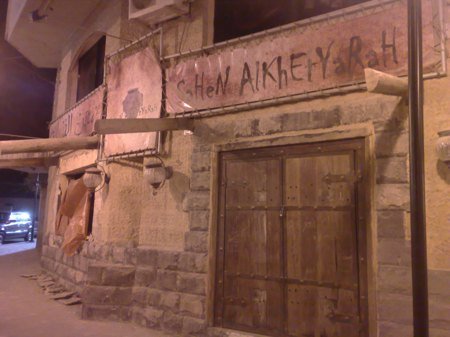
Absolutely the worst example on the street. Look at the horrible sign, farm door and wooden poles. Disaster.
Comments
14 responses to “New Rainbow Street and the dangers of the creeping “village style” !”
I honestly loved the new changes on Rainbow street as it reminds me alot of Ashrafeyeh in Beirut and my favourite part is the small cafes, maybe soon we can have small bars and cafes like Juniezeh in Beirut. Buy why do we have three pyramids in the street?? That was funny!
Great post Ahmad. Although your point on the village look is completely head on, but I personally also feel that they should not go with a space-age, modernistic look either. One of the things that really, really annoyed me with the renovations is that they went ahead and “modernized” some really gorgeous old staircases. The one that annoys me the most is the staircase that leads down from Jara Market to Wild Jordan. I will post a picture of it later, but they basically completely killed a century old staircase with steel and concrete additions that are really horribly done.
i thought Rihani is a good example..
where is Licky licious picture?!
I thought you are going to critisize LL for being modern in Rainbow Street, instead you did the contrary, which is a relief for me, having luckily gotten it right
Roba, you are totally right. Did they really completely replace the staircase from Jara to Wild Jordan? If so that would be totally the wrong move.
The “shell” of the street should be the building as they are. No “modern” or “village” stuff should be added on the facades. Signage can be a mix that reflect diversity and vitality. Some can be neon, some can be a piece of framed sheet metal like the old shop signs of Amman.
Hussein: Rihani is NOT a good example. Those fake wooden pieces and the fake stone are wrong.
Observer: Congratulations on the opening of LickyLicious. Great idea. Thank gooodness you didn’t call it “Grandma’s Ice Cream Tavern”. As a shop owner, please help spread the right culture for Rainbow amongst your neighbors. I am seriously scared people will screw the street up!
sahn il khityara is a barn gate, definitely
But not writing in arabic is a sin to a cultured street in an arab city, Al-Qudos and al khityara examples.
on a different topic, having some cultured restaurants non arabic menus. Blue Fig for example stands for a Jordanian brand with an international exposure demonstrated by the theme weeks they hold, the art work placed on their walls for rising or established Jordanian artisits. An american friend once asked why don’t they have an arabic menu since they present such an identity!
Thank you Ahmed.
Actually I have never thought of the heritage of the street this way and was kind of wondering if I went wrong with the design of LL or not. This is a wake up call from you. You are right. We ought to maintain the right culture .
.
I didn’t like that last photo with the wooden beams either, but the terrace is lovely. I hope the pyramids aren’t really made of glass, but some sort of glass like plastic polymer.
Why does it have to be Rainbow Street’s heritage that’s heighlighted as opposed to Amman’s heritage.
I liked the Rigani Gallery facade much more than Batata!
Hani,
Thanks for the contribution..
Rainbow Street should be Rainbow Street. Just by being itself, it reflects Amman’s heritage by default. That’s what so brilliant about that street.
The Rihani facade uses a design language that is forced on the street. We don’t need yellow stones and wooden beams to say “heritage”. We just need to let these buildings that were built over the past 80 years speak for themselves.
I mean, it’s like looking at a black and white photo of your grandparents. If your grandfather wath wearing a suit inn his picture from 1945, you don’t need to scan the photo into photoshop and add a fake dishdasha on him. This is exactly what will happen with Rainbow if the shop owners don’t understand what they have.
Thanks..
Great post Ahmad, Actually i am in the middle of this design crisis , I am working on remodelling a 1920 Barn to a useable residential house, I’m going strikingly contemperary with the design. And to me every case is different……and it is a matter of preferences. I wouldnt go crazy if I was given the choice to work on the Rainbow street, as I remember it is got its own warm atmosphere that should be gently preserved, I hate the way we try to modernize our heritage in a tacky way…..
Is Al quds restaurant is Abo Al adeeb( the yummiest falafel sandwiches ever?).
Regarding all Quds Falafel signage, never noticed that, but it brings me to this question:
Why is it that most int’l food chains – mostly American ones- have fully arabized menus to offer their customers in contrast with the delusion of prestige driven English-only menus of locally established restaurants, including Lebanese franchises?
I can understand the theme Za’tar Wa Zeit is trying to establish with the arabizi adaptation (with proper Arabic underlined for reference), but the rest of the folks are just out of their elements, No?
I can not understand the meaning of the signs in English, what has the Arabic language to make it so excluded from the world of design. or the usual our inferiority!
I do not have the opportunity to visit the road, but by the photo I can see a language of contradizione typical of modernism stone/glass heavy/ light. ect ect that is ok perhaps a little random
Again, a very true “A-class” post Ahmad!
Can’t but agree with everything you said, especially Al Quds Falafel!
I always thought that it looked almost perfect before, considering what Rainbow Street means to Ammani.s! They should have simply invested in creating an urban seating area next to it!
By the way, I have an old photo of this cinema corner (2004) but I think it looked disastrous then. I guess you meant how it looked like in its good-old-days.. then OK, you probably have a point!
(how can i send you the pic?)
The past two years I have taken my two-week vacation in Amman. Each time I ask to come back to Rainbow Street more and more. It reminds me of a famous street here in Miami Beach called Lincoln Road. More then 40 years ago the streets were closed down completely and the sidewalk eventually extended across the road. Now it has hundreds of fashionable restaurants and sidewalk restaurants, cafes, putside nargileh cafes, shops, bookstores, movies, gyms, the New World Symphony, and each weekend, when the weather is good, we have antique and bric-a-brac mini-festivals where you can browse for hours.
I envision the Rainbow district could grow into a fabulous meeting place like this which will exist day and night, which will attract young and old to a vibrant, progressive atmosphere in Amman.
I suppose the cobblestone streets do create a “issue” but who knows what could be done with that? Only the limits of creativity can stop something like what I described above to happen!